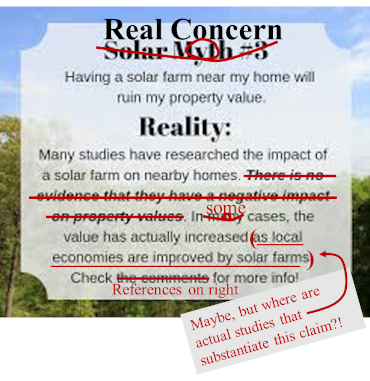Is a solar farm planned to be built near your rural neighborhood?

If so, how will it affect your property value?
Some solar farms do have an impact on property values—some positive, some negative. Of the 980 utility-scale solar farms studied across 23 states, the majority, 66%, have no impact whatsoever.
For those remaining solar farms that do impact property values, the average change in value ranges from -7% decrease in value to +3% increase in value. When there’s a negative impact, it’s likely due to proximity and size of the solar farm. Starting at one mile away, the closer to the solar farm and the larger it is, the more likely the value will decrease. At 1/10th mile away, the property value could drop by as much as -7% to -12%.
The studies referenced herein are thorough and represent the effect of solar farms on property values in several states. Data from actual residential home sales located near utility-scale solar farms form the basis for the study results.
Nonetheless, results from these multistate studies only form a statistical profile for estimating property value impacts in general. That is, if, let’s say, 66% of property values are unaffected, 11% increase in value, and 23% decrease in value, these statistics only give the odds for how much, if at all, any particular property will be affected. They really can’t be used for predictive purposes. In other words, who can say for sure what will be so for your property?
The best study also attempts to answer that question. It’s a thorough independent study titled, An Exploration of Property-Value Impacts Near Utility-Scale Solar Installations. This study, directed by Dr. Varun Rai and completed in 2018, was produced by the Policy Research Project (PRP), LBJ School of Public Affairs, The University of Texas at Austin. It’s a 68 page research paper and represents 23 states of the 42 known to have utility-scale solar farms as of 2018. Here’s a short excerpt:
“... some respondents did estimate a negative impact on home prices associated with solar installations. When averaging estimates across all respondents, the estimated impact was negative up to 1,000 feet, one half mile and one mile for 1.5MW, 20MW and 102MW facilities, respectively. The averages suggest that respondents estimate that greater proximity to utility-scale solar installations is linked to a more negative property value impact, and that those impacts would be larger as the size of the solar installation increases. In discussing the averages, however, it is worthy of note that highly negative estimates from a few respondents appeared to be pulling the average away from the median. For a discussion of property value impacts in dollars, see Appendix D.7.”
— Dr. Varun Rai, Project Director